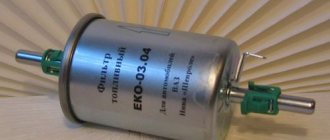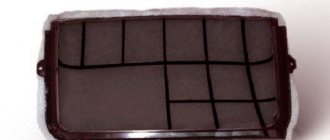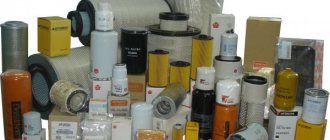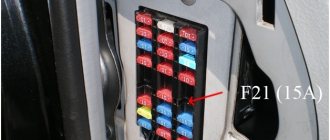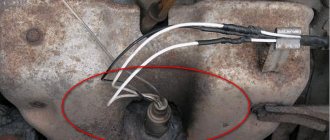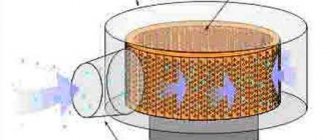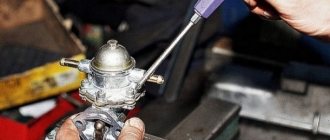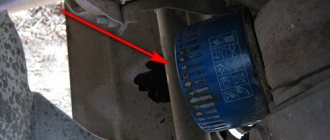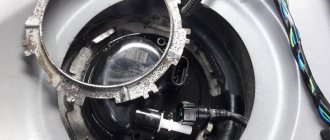Why are they even needed?
Forced fuel cleaning is a necessity to ensure the performance of any engine running on liquid fuel.
Filling the filter cavity, gasoline passes through a layer (there may be several of them) of filter material, leaving on its surface particles of dust, dirt and other solid inclusions that adversely affect engine parts. If the “food” ration of a car engine is diesel fuel, then an additional separator is required that will help clean the fuel, in addition to mechanical inclusions, from water content.
Its operating principle is based on the fact that water is heavier than diesel fuel, and centrifugal force helps separate them from each other. Due to the specific operation of separators, most of them are heated.
How does a fuel filter work?
Fuel filtration on modern cars is two-stage. In front of the fuel pump, a fine nylon receiving mesh screens out contaminant particles. And then the final screening of particles larger than 10 microns (for gasoline) is carried out by a fine filter.
Where is the fuel filter located?
The location of the fuel filter depends on the engine type and vehicle model. In carburetor engines, the filter is always located next to the fuel pump and carburetor. In injection cars, the fuel filter is installed near the pump. If the pump is in the fuel tank, then the filter is under the body, not far from it. If the pump is under the hood, then the filter is next to it. In diesel engines, the fine filter is always located near the injection pump and injectors, and the installation location of the coarse filter depends on the model (not every one has two filters).
On most cars that were manufactured after 1980, a fine filter, and often a coarse filter, is installed from the factory. Therefore, if you regularly replace both filters, installing another one will not provide any benefits. If for some reason the car does not have filters, or only one, then installing a second filter will increase the service life and quality of fuel purification. Before finding out whether your car needs an additional fuel filter, find the filter installation locations in the owner's manual or a diagram downloaded from the Internet. Then check to see if the filters are where they need to be. If filters are not in place, inspect all fuel lines. Perhaps the previous owner of the car installed them in a different location. For this operation you will need an inspection pit or a lift. If there are no filters, or only a coarse/fine filter is installed, install the missing one.
How often to change the fuel filter
If you use high-quality gasoline, which you purchase from a trusted supplier, then change the filter every 10–15 thousand kilometers. It is best to do this at every oil change. If you don’t know what quality of fuel you put into your car, change the filter every 5–7 thousand kilometers.
Removing the high pressure fuel filter
What cars are equipped with a fuel filter?
Fuel filters are installed on both gasoline and diesel cars. Moreover, the latter have higher requirements for filtration quality than gasoline ones. This is due to the fact that the pressure under which fuel is injected into the diesel cylinders is much greater than that of their gasoline counterparts. And higher pressures require smaller clearances in pumps and injectors; in this case, the particles passed by the filter must be much smaller than the gap so as not to cause wear.
Description
The purpose of the fuel filter (FF) is to filter out dust particles and contaminants and prevent them from entering the engine fuel system. In the absence of a cleaning element in the system, dust and other harmful components clog and damage the fuel system.
Cross-section of the fuel filter: 1 - filter element for injection cars, 2 - its housing
The filtration process consists of two or more degrees of purification (depending on the structure of the filter and its production). The first degree is called coarse, because it manages to filter out large particles of dirt that entered the gas tank along with the fuel. The second is a fine filter, which is located somewhere between the gas tank and the vehicle’s engine (this “somewhere” can be in different places, depending on the car).
Filters vary in their design. They are installed based on the type of fuel system. There are three types:
- carburetor;
- injection;
- diesel
The specificity of diesel filters is that this type of engine is very vulnerable, so the fuel for the systems must be as clean as possible. In this case, the car’s fuel undergoes three stages of purification - in the gas tank, and then coarse and fine cleaning. The purpose of a diesel engine fuel filter is to prevent water from entering the combustion chamber. If you take these factors into account, it becomes clear why a high-quality TF for a diesel car costs an order of magnitude more than a cleaning element for a gasoline engine.
Diesel TF: 1 - diesel, 2 - pump emulsion, 3 - dirt removal, 4 - clean fuel with condensate residue, 5 - hydrophobic material, 6 - moisture separator
By design, filters can be of two types: prefabricated and non-removable. If a non-separable gasoline cleaning component is installed in a car, then if it is unsuitable, the fuel filter is completely replaced. Prefabricated TFs do not require a complete change—it is enough to replace the filter element.
Remember: a properly selected TF specifically for the car model will save fuel and increase the frequency of its replacement. If the component replacement process is not done in a timely manner, the consequences for the fuel system can be disastrous.
If you don’t know where the fuel filter is located and how often it is changed, read the operating instructions. We can say that in most diesel and carburetor cars the filter is located in the engine compartment. Gasoline purification components in injection cars are located under the bottom of the car (if the filter is not dismountable) or under the rear seat. In this case, the TF is located directly in the fuel pump and replacing it involves replacing the fuel pump mesh.
We recommend: Independent replacement of the VAZ 2114/15 heater radiator: how to carry out the procedure in different ways
Injection fuel filters are not subject to corrosion because they are made of aluminum or plastic alloys.
Collapsible TF
Types of fuel filters
All fuel filters are distinguished by the following parameters:
- degree of cleaning (fine, coarse);
- type of case (metal, plastic);
- working pressure (low, high);
- type of fuel (gasoline, diesel fuel).
- Coarse filters are installed in front of the fuel pump of gasoline engines. On diesel engines, if there is a possibility of refueling with low-quality diesel fuel, both types of filters are installed in front of the high-pressure fuel pump (HPFP).
- Filters in a plastic housing are used for pre-cleaning in low-pressure fuel lines. Filters in a metal casing are used both in low-pressure fuel lines of diesel engines, in which it is necessary to provide the function of manual fuel pumping, and in high-pressure fuel lines.
- Low pressure filters are used only in the fuel lines that correspond to them - before the pump in injection engines, as well as before and after the fuel pump in carburetor engines. The filling and filter housing are not designed for high fuel pressure, and also have a lower degree of filtration. High pressure filters (up to 10 atmospheres) provide much better protection, but they only work well in their areas. Installing such a filter in a low pressure area will cause a serious drop in the amount of fuel that reaches the pump or carburetor.
This is interesting: Clutch drives: what does it mean, why and what to do
Carburetor filter
Since a carburetor engine has low pressure, the working mixture enters the engine through special rubber hoses. It is into them that the filter element “crashes”. This can be a product made of plastic or metal. The product has 2 tubes (inlet/outlet). For maximum reliability, the hoses are secured using special clamps.
Injector filter
The peculiarity of this element is the transfer of key functions to the central electronic unit. The working mixture enters the engine under high pressure, and this requires the presence of metal fuel lines of the highest quality. If we talk about the fuel pump itself, it is made of steel or other particularly durable metals. Threaded elements are used as connectors.
Diesel filter
Diesel engine fuel is considered the “dirtiest” of those existing today; it requires increased purification from all kinds of impurities. Paraffins pose the greatest danger to the internal elements of a car. They, transforming into crystals, clog the main gaps in the parts. Therefore, vehicles running on diesel fuel are usually equipped with two filtering devices – the main one and the additional one. This allows you to clean the fuel from unnecessary impurities by 100%.
Types of filters
In addition, filter elements installed on vehicles differ in the following characteristics :
- degree of cleaning (coarse/fine);
- type of casing (metal/plastic);
- working pressure (high/low);
- type of fuel (diesel/gasoline).
How to change fuel filters
After deciding on the need to replace the filters and their location, the car owner needs to understand whether it is possible to replace the filters on their own, or whether it is better to go straight to a car service center.
Most often, replacing two fuel filters at once, built into a single unit with a fuel pump and located in the tank, is quite difficult. To carry out this procedure, you must have a number of specific machine repair skills.
In addition, do not forget that on many new car models, the manufacturer provides for replacing the fine filter only by replacing the entire unit along with the built-in fuel pump, which is quite expensive (such a replacement is planned by marketers in order to increase the owner’s expenses for maintaining the car). That is, replacing the filter separately from the pump in such machines can require a lot of effort and time.
In the case of a fine filter located on the fuel line, replacing it is much easier, and this can be done by almost any car owner who knows how to change tires on a car.
Fuel filter life
Modern automotive fuel purification systems have 2 degrees of purification. The first degree removes mechanical impurities: sand, dust particles, etc. The second is a fine filter, which is installed on the fuel line between the engine and the gas tank.
Service center specialists recommend changing the fuel filter every 60,000 km.
If the filter is not changed for a long time, the degree of contamination causes it to create a load on the fuel pump. In this case, the fuel pump quickly breaks down. In addition to the load on the fuel pump, a dirty fuel filter affects engine performance. The internal combustion engine may not start at all, it may run jerkily, or adjust. If there is engine tripping, then you need to quickly find the cause, because it could be a burnt out valve or a leaky piston. Due to improper engine operation, incorrect gear shifting may occur. This is especially bad for an automatic gearbox, because the automatic transmission can be guided by engine speed, but when shifting, it jumps by itself.
Why is it needed?
There is a coarse filter that comes first from the gas tank. After all, first the lid where the fuel tank is located is opened, a gun is inserted there, the magic button is pressed and the fuel flows. Yes, it takes a lot of your money along the way, but what can you do? The location of the tank can be on the left or right, but this does not play a special role. Coarse cleaning, which is a mesh that traps large particles of debris.
This is followed by a fine filter. This is exactly what we will talk about. This element is called a fuel filter. With its help, small particles are retained. But even they can penetrate your diesel engine or gasoline injector.
Dust, dirt, debris, rust elements. All this can penetrate the system, causing a clogged pipe, tube, valve, fuel hose, or fuel pump components. Nothing good will come of this if timely replacement is not made.
To understand how to replace the filter, which element to choose and how to choose an analogue for the device you are going to change, you need to have at least a basic understanding of such an important component of the car.
I suggest starting with varieties.
Kinds
Modern fuel filters installed on Ford Focus, Nissan Almera, Hyundai Solaris, Nexia, Mazda, Opel, BMW e60, Renault Logan and Megane, Kia Rio and many others have at least two degrees of purification.
- First degree. This is a rough cleansing that allows you to get rid of large contaminants. Not to be confused with a regular mesh in the tank, which is not available everywhere.
- Second degree. Fine cleaning. This is the main task that falls on the shoulders of the filter.
And here you probably have the main question - where is the filter device located? I don't know. No, I can answer, but if you tell me specifically what make of your car or what year of manufacture. After all, on the same Chevrolet Niva, different Opel, Toyota, Mazda models, on the Volkswagen Passat B3, as well as on the domestic VAZ 2114, 2112 and 2110, the location may differ.
However, they are always located somewhere between the engine and the gas tank, since the filter's job is to prevent contaminants from entering the engine while the fuel moves from the tank to the engine. What's in the gas tank itself? That's right, a coarse cleaning device. This is an additional filter element so that any unscrupulous gas stations do not spoil your car.
Now let’s talk about the types of filters themselves. What element will be on the car? It depends on the type of engine. There are three of them, as you know. Except for electric motors. Well, there is no need for a fuel filter, as you understand.
Therefore, there are three types of filters:
- carburetor;
- diesel;
- injection.
Location
So you bought yourself a brand new sedan and you think it’s time to change the filter for this engine. Want to choose the best? Well then, take a closer look at Cummins devices. Mann, Hertz. They have proven themselves well, and they cost quite a bit.
You probably know whether your engine is diesel, injection or carburetor. This is important to understand the location of the fine filter, that is, our today's hero.
- Carburetor. In these engines, the TF (fuel filter) is placed in front of the carburetor itself, and is often in a transparent housing to control contamination. These are the most basic devices, because the carburetor is the least demanding on the quality of fuel.
- Injector. It uses nozzles and therefore requires high-quality filtration. And the fuel is supplied under high pressure. Therefore, the filters are enclosed in durable metal housings. The TF has to be regularly maintained, cleaned and monitored for its condition. They are placed mainly under the bottom of the car to make it easier to dismantle and replace.
- Diesel. A diesel engine also needs high-quality purified fuel, since the system is quite sensitive. Diesel fuel has a higher moisture content than gasoline. The TF is designed to filter debris and remove accumulated moisture. A separator is provided for this purpose. The location is quite simple - between the engine and the pump that pumps fuel.
We recommend: The quietest and softest summer tires
Any fuel system must include a TF. They are replaced assembled, that is, there is no point in removing the filter elements themselves (usually special paper), leaving plastic or metal. Be sure to look at the number and article number of the filter that is installed on your machine, and check the operating manual from the factory. This is the only source of truthful information regarding the maintenance of your particular vehicle in this configuration and with this type of engine.
What happens if the fuel filter is clogged?
The filters are, of course, damaged by the dirt that gets into the tanks of our cars along with the fuel. And it’s not the oil refineries that are to blame. Fuel can become contaminated during storage and transfer. And the driver will feel the clogging of the fuel filter by the behavior of the car, and first in those modes where the instantaneous fuel consumption of the engine is maximum. These are driving modes at high speeds and intense acceleration. In this case, the engine will lose traction and operate intermittently, although at idle and in “quiet” modes everything will look decent.
This is interesting: How to adjust the side door on a Gazelle?
Signs of a clogged fuel filter
As we have already noted, fuel quality is one of the main reasons for the failure of car engines. Simply put, one day the fuel filters no longer cope with cleaning what comes from the tank to the engine. To find the root of evil, let's turn to the theory of operation of internal combustion engines (ICE).
Textbooks claim that the highest coefficient of performance (COP) is achieved at a certain ratio of air and fuel in the combustion chamber. Ideally it is 14.7/1.
You can imagine what will happen if this ratio is disrupted due to a clogged filter. Even electronics, designed to control the ideal air-gasoline ratio, will have a very difficult time balancing the situation.
What are the main manifestations of a clogged fuel filter:
- Unstable engine operation at idle. The tachometer needle twitches and stubbornly stays at high speeds. New and obviously false notes are added to the melody of the engine. Additional vibration appears. There are frequent cases when the engine begins to “trouble.”
- Loss of engine thrust. In simple terms, pressing the accelerator pedal no longer produces the desired result.
- The car starts to have trouble starting. There is a clear lack of fuel. All this ultimately leads to the fact that one day your “iron horse” will generally refuse to fulfill the will of the owner, as always, at the most inopportune moment.
Note that the problem of timely replacement of the fuel filter is not new. To help motorists today, some manufacturers offer fuel filters equipped with pollution control features.
The operation of the sensors is based on the difference between theoretical pressure and actual (or inlet/outlet) flow.
In modern cars, the lamp for critical filter clogging is displayed on the instrument panel, which is convenient for receiving a signal that it is time to change the “guard of cleanliness”.
Signs and causes of premature clogging
While driving, symptoms of contamination of the mesh elements often appear, by which you can determine when to change the fuel filter. They look like this:
- it is difficult to start the engine “cold” - the fuel pump needs more time to increase the pressure in the system;
- when trying to accelerate dynamically, a “failure” is observed - the car slowly picks up speed due to a banal lack of fuel;
- the same phenomenon occurs when driving with increased load - uphill, with a trailer or with a maximum number of passengers;
- after sharply releasing the accelerator pedal, the engine does not go to idle and stalls.
The reason for this behavior of the car is premature blockage. The malfunction occurs when constantly driving on dusty roads or refueling with low-quality fuel.
A separate point regarding separators on diesel engines: if you pour summer diesel fuel without additives into the tank during the cold season, the mesh and water separator may become covered with a film of paraffin. In such a situation, the fuel filter must be changed without delay.
We recommend: Replacing the VAZ 2110 heater radiator: instructions
If you ignore the symptoms listed above or simply do not install a new consumable part on time, then the dirt, along with water, breaks further to the power unit. This is fraught with the following consequences:
- On carburetor engines, foreign particles clog the smallest holes in the fuel path. These are the idle jet and the calibrated economizer hole. Later, the main fuel jets also become clogged. Signs: increased gas mileage and engine reluctance to idle.
- On injection and diesel engines, injectors suffer. Deposits form in the valve part, causing increased wear. If ultrasonic or other cleaning is not performed on time, the injectors will leak and poorly spray the air-fuel mixture into the cylinders. Symptoms are very difficult hot starts and high fuel consumption.
- Water or condensate getting into diesel cylinders can lead to costly repairs. The fact is that the combustion chambers of these engines are small, and the pressure in the cylinders is high. The presence of incompressible fluid in the chamber can lead to water hammer and cracks in the cylinder head.
Note. Leaking injectors must be replaced; cleaning them will not help. The price of parts, especially for diesel engines, is quite high. It’s easier to change the filter element 5–10 thousand km ahead of schedule.
If you need to change the filter due to premature contamination, which manifests itself in unstable engine operation, then debris has probably gotten into the carburetor or injectors. In the first case, it is advisable to blow out the idle jet (it is unscrewed from the outside), and in the second, visit a car service center to wash the nozzles.
Preparing the car for replacing the fuel filter
Before removing the fuel filter, the car must be jacked up. You should first install stops under the wheels - wooden blocks or bricks - and pull out the hand brake lever. Having raised the car to the required height, supports are placed under the bottom to ensure a stable position.
Then you need to reduce the pressure in the fuel line by pulling out the fuel supply fuse and waiting until the engine stalls. To prevent gasoline vapors from igniting, the negative terminal should be removed from the battery.
Tools
Before you change the fuel filter, you need to stock up on a set of tools. Among them:
- jack;
- pliers;
- flat or Phillips screwdriver (depending on the type of screw);
- knob;
- wrenches: socket, adjustable and ratchet.
Replacing the fuel filter
The basic procedure for replacing the filter element on most types of cars is similar - at the end of the life of the filter element, the old device is removed and a new filter is installed in its place.
The main distinguishing feature of different engines is the location of the filter itself. And the complexity of the work and other details depend on this
To dismantle/install the TF in vehicles with different types of engines, special tools and accessories may be required. They need to be prepared in advance. Next, we will tell you how to change the filter for each specific type of engine, explaining how to remove the old one and install a new filter device.
Replacing the TF on the carburetor
In a carburetor engine, the filter device is usually located under the hood. It is made of plastics/light alloy metals, and its installation will be simple and understandable for everyone.
First, you need to remove the clamp on each side, then dismantle the filter device itself. When installing a new TF, it is extremely important to install it correctly, without confusing the direction (inlet/outlet). To make it easier for the car owner to navigate, there is an arrow on the body, which should point towards the gas tank when installed.
This is interesting: How to make a car window defroster (anti-ice) with your own hands?
Having put the clamps in place, you need to pump in fuel using the fuel pump handle. If at this moment a slight whistle is heard, the seal is broken. Metal clamps will help ensure reliable fastening.
Important! The fuel device must not come into contact with the cap on the head and the block body.
Replacing the filter on the injector
Replacing the TF on the injector
The supply of the working mixture to the cylinders of an injection engine occurs under high pressure, and therefore the fuel pumps for such engines are made of metal with threaded fasteners at the connections. The injector TF can be located in the engine compartment or under the bottom.
- First, you need to reduce the pressure in the system, for which you need to remove the middle one in the safety block, which is located at the gear lever (usually it is responsible for the functioning of the pump).
- Then you need to start the engine and wait until it stalls (usually no more than a minute).
- Next, using the appropriate tools, dismantle the old filter and install a new one. Here the arrow should point in the direction of fuel flow.
After finishing the work, you need to put the fuse in place. After this, try to start the power unit.
Surely, the first attempt will not bring results, since it takes some time to stabilize the working pressure in the system.
Replacing TF on a diesel engine
In conclusion, we will tell you how to change the filter on cars with a diesel engine, which are extremely sensitive to the characteristics of the fuel being poured. A significant volume of impurities clogs the injectors, and this affects the correct operation of the power unit.
We have already mentioned above that diesel cars have 2 filters (pre-filter/fine filter). The second one usually needs to be changed after 10-15,000 km. It is located in the front part of the car, and to get to it, you will need to remove the wheel with the fender liner. After this you need to do the following:
- Roll up the tray.
- Remove the chip from the water meter.
- Remove the fittings by pressing the buttons located on the back wall.
- Remove the water level meter and the plug at the bottom.
- Provide the dismantled parts with new parts that ensure tightness (rubber gaskets/washers are supplied with the filter).
- Place a water meter with a plug on the filter device being installed, then place it on the machine.
During installation, do not hit the water meter - all work must be carried out with the utmost care.
The color marks on the filter device and the color of the fittings will help you check the correct assembly - they must match!
Replacing a filter on a diesel engine
And in order for the car to start after completion of work, before installation you need to fill the new fuel filter with diesel fuel.
To expel excess air, you can rotate the starter for 5-7 seconds, after first squeezing each nozzle a little. After 2-3 similar procedures, small bubbles appear near them. Holding the injectors on the driver's side, you need to repeatedly rotate the starter several times. After this you need to clamp the remaining ones. These steps will help start the car engine.
Where is the fuel filter located?
When asked where the fuel filter is located
fine cleaning cannot be given a definite answer, since its exact location depends on the car model and the type of fuel system implemented in it.
But in any case, it is installed between the engine and the fuel tank. Often the filter is installed - under the hood
,
under the bottom
or
in the fuel tank
of the car along with a fuel pump and a coarse fuel filter.
In a carburetor system
The filter is installed
in front of the carburetor
. Most often it is made in a transparent housing to facilitate control of clogging. This design allows you to visually determine when changing the fuel filter becomes extremely necessary. Filters for carburetor engines are the simplest, since such engines are not too demanding in terms of the purity of the fuel mixture.
In injection engines
Due to the use of nozzles, high-quality filtration is required to filter out particles with a size of 10 microns.
Considering this, as well as the high pressure in the fuel supply system, the fuel filter itself is most often made of metal, and the filter element requires regular maintenance and cleaning. Such filters are located under the bottom of the car
, which simplifies access to them.
In diesel engines
Fuel purification must be of high quality due to the increased sensitivity of fuel equipment.
Since diesel fuel contains a lot of moisture, filters for such engines differ from gasoline ones because they must condense and remove water from the fuel mixture. Well, the fuel filter is located in diesel engines, also between the fuel pump and the engine
.
It should be noted that due to the paraffin content in diesel fuel, filters are often equipped with heating, since this substance crystallizes in the cold and can quickly clog the filter element.
Regardless of the engine type, manufacturers recommend replacing the fuel filter or filter element (on diesel engines) at least 30,000 km.
Safety precautions
When replacing the fuel filter yourself, it is important to follow the safety requirements:
- Work should be carried out outdoors or in a garage (box) with good ventilation. Otherwise, gasoline vapors or spilled fuel may ignite, often leading to a fire.
- It is strictly forbidden to smoke near the machine or perform work near open flames.
- To protect your eyes and skin from chemical burns from fuel contact, you must wear safety glasses and rubber gloves when working.
How to check the filter without opening the hood
An easy way to check whether the fuel filter is dirty is to sharply press the gas pedal while the car is moving at low speed and watch how the car accelerates. If the car “slows down”, accelerates slowly with the accelerator pedal pressed hard, or accelerates jerkily, then the fuel supply is intermittent. Most likely, the filter is dirty and needs to be replaced.
Sources
- https://autoot.ru/zamena-toplivnogo-filtra-gde-on-nahoditsya.html
- https://www.zr.ru/content/articles/909842-toplivnyj-filtr-menyat-ili-i/
- https://VipWash.ru/toplivnaya-sistema/toplivnyy-filtr
- https://tolkavto.ru/remont-i-obsluzhivanie/toplivnaya-sistema/kak-zamenit-toplivnyj-filtr.html
- https://autostuk.ru/zamena-toplivnogo-filtra.html
- https://difa-avk.ru/statyi/kak-zamenit-toplivnyy-filtr/
[collapse]

